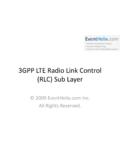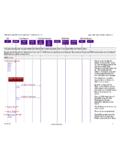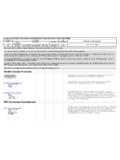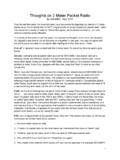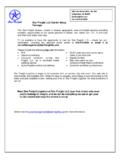Transcription of 3GPP LTE MAC Layer - EventHelix.com
1 Telecommunication design systems engineering real-time and embedded systems3 GPP LTE packet Data Convergence Protocol (PDCP) Sub Layer 2009 Rights telecommunication design systems engineering real-time and embedded systemsLTE PDCP Sub Layer FunctionsHeader compression and decompression with ROHCC iphering and deciphering of user and control plane data Transfer of data and PDCP sequence number maintenanceIntegrity protection and verification of control plane dataPDCP Header compression and decompression of IP data flows using the ROHC protocol; Transfer of data (user plane or control plane); Maintenance of PDCP SNs; In-sequence delivery of upper Layer PDUs at re-establishment of lower layers; Duplicate elimination of lower Layer SDUs at re-establishment of lower layers for radio bearers mapped on RLC AM; Ciphering and deciphering of user plane data and control plane data.
2 Integrity protection and integrity verification of control plane data Timer based discard Duplicate discarding 2009 telecommunication design systems engineering real-time and embedded systemsPDCP in the LTE Protocol StackMMENASeNodeBRRCPDCPRLCMACPHYUENASRR CPDCPRLCMACPHY 2009 telecommunication design systems engineering real-time and embedded systemsLTE PDCP Layer View 2009 BearersUE/E-UTRANPDCP sublayerRLC sublayer PDCP entiy PDCP - PDURLC - SDUC-SAPPDCP-SAPPDCP-SAPRLC UM-SAPRLC AM-SAPPDCP entityPDCP telecommunication design systems engineering real-time and embedded systemsPDCP Layer Functions 2009 Interface (Uu)UE/E-UTRANE-UTRAN/UETransmitting PDCP entityCipheringHeader Compression (u-plane only) Receiving PDCP entitySequence numberingIntegrity Protection (c-plane only)Add PDCP headerHeader Decompression (u-plane only)DecipheringRemove PDCP HeaderIn order delivery and duplicate detection (u-plane only)Integrity Verification (c-plane only)Packets associated to a PDCP SDUP ackets associated to a PDCP SDUP ackets not associated to a PDCP SDUP ackets not associated to a PDCP telecommunication design systems engineering real-time and embedded systemsROBUST HEADER COMPRESSION3 GPP LTE packet Data Convergence Protocol (PDCP)
3 Sub Layer 2009 telecommunication design systems engineering real-time and embedded systemsRoHC Modes Packets are only sent in one direction: from compressor to decompressor. This mode therefore makes ROHC usable over links where a return path from decompressorto compressor is unavailable or Mode (U-Mode) Similar to the Unidirectional mode, except that a feedback channel is used to send error recovery requests and (optionally) acknowledgments of significant context updates from the decompressorto compressor. The O-mode aims to maximize compression efficiency and sparse usage of the feedback Optimistic Mode (O-Mode) More intensive usage of the feedback channel and a stricter logic at both the compressor and the decompressorthat prevents loss of context synchronization between compressor and Reliable Mode (R-Mode) 2009 telecommunication design systems engineering real-time and embedded systemsRoHCCompressor StatesInitialization and Refresh State Compressor has just been created or reset Full packet headers are sent First Order State Detected and stored static fields (such as IP address and port number)
4 Sending dynamic field differences Compressing all static fields and most dynamic fieldsSecond Order State Suppressing all dynamic fields such as RTP sequence numbers, and send only a logical sequence number and partial checksum Other end regenerates the headers and verifies the headers. Compressing all static and dynamic fields 2009 telecommunication design systems engineering real-time and embedded systemsRoHCCompressor States in Unidirectional Mode (U-Mode) 2009 and RefreshFirst OrderSecond telecommunication design systems engineering real-time and embedded systemsRoHCCompressor States in Bidirectional Optimistic Mode (O-Mode) 2009 and RefreshFirst OrderSecond OrderOptimistic/AckNack/UpdateStatic NackStatic NackOptimistic/ telecommunication design systems engineering real-time and embedded systemsRoHCCompressor States in Bidirectional Reliable Mode (R-Mode)
5 2009 and RefreshFirst OrderSecond OrderAckNack/UpdateStatic NackStatic telecommunication design systems engineering real-time and embedded systemsRoHCDecompressorStates 2009 ContextStatic ContextFull ContextSuccessSuccessMultiple Compression FailuresMultiple Compression telecommunication design systems engineering real-time and embedded systemsPDCP PDU FORMATS3 GPP LTE Radio Link Control (RLC) Sub Layer 2009 telecommunication design systems engineering real-time and embedded systemsControl Plane PDCP PDUsPDU for SRBPDU for Interspersed ROHC Feedback (RLC AM and UM Mapped DRBs) 2009 1 Oct 2 Oct NOct N-1 Oct N-2 Oct SNRRRMAC-IMAC-I (cont.)
6 MAC-I (cont.)MAC-I (cont.)..Interspersed ROHC feedback packetD/CPDU TypeRRRROct 1 Oct 2 PDU for PDCP Status Report(RLC AM Mapped DRBs)..Bitmap1 (optional) D/CPDU TypeBitmapN (optional)FMS (cont.)FMSOct 1 Oct 2 Oct 3 Oct 2+NSRB: Signaling Radio BearerDRB: Data Radio telecommunication design systems engineering real-time and embedded systemsUser Plane PDCP PDUsData PDU with Long PDCP SN (12 bit)(RLC AM and UM Mapped DRBs)Data PDU with Short SN (7 bit)(RLC UM Mapped DRBs) 2009 SN (cont.)DataD/CPDCP SNRRROct 1 Oct 2 Oct SNOct 1 Oct telecommunication design systems engineering real-time and embedded systemsPDCP PDU Fields 1 5 bit for SRBs 7 or 12 bit for DRBsPDCP SN (Serial Number) Uncompressed PDCP SDU (user or control plane data) Compressed PDU SDU (user plane data only)Data Contains message authentication code Contains 0 in control plane messagesMAC-I 32 bit number made from Hyper Frame Number (HFN) and PDCP SN HFN bits = 32 PDCP SN bitsCOUNT Reserved.
7 Should be set to (1 bit) 2009 telecommunication design systems engineering real-time and embedded systemsPDCP PDU Fields 2 0 = Control PDU; 1 = Data PDUD/C (1 bit) 0 = PDCP Status; 1 = Interspersed ROHC Feedback packet ; Rest ReservedPDU Type (3 bit) PDCP SN of the first missing PDCP SDUFMS (12 bit) The MSB of the first octet of the type "Bitmap" indicates whether or not the PDCP SDU with the SN (FMS + 1) modulo 4096 has been received and, optionally decompressed correctly. The LSB of the first octet of the type "Bitmap" indicates whether or not the PDCP SDU with the SN (FMS + 8) modulo 4096 has been received and, optionally decompressed Contains ROHC Feedback packetInterspersed ROHC Feedback packet 2009 telecommunication design systems engineering real-time and embedded systemsPDCP Variables The variable Next_PDCP_TX_SNindicates the PDCP SN of the next PDCP SDU for a given PDCP entity.
8 At establishment of the PDCP entity, the UE shall set Next_PDCP_TX_SNto The variable TX_HFN indicates the HFN value for the generation of the COUNT value used for PDCP PDUsfor a given PDCP entity. At establishment of the PDCP entity, the UE shall set TX_HFN to 0. The receiving side of each PDCP entity shall maintain the following state variables:TX_HFN The variable Next_PDCP_RX_SNindicates the next expected PDCP SN by the receiver for a given PDCP entity. At establishment of the PDCP entity, the UE shall set Next_PDCP_RX_SNto The variable RX_HFN indicates the HFN value for the generation of the COUNT value used for the received PDCP PDUsfor a given PDCP entity.
9 At establishment of the PDCP entity, the UE shall set RX_HFN to For PDCP entities for DRBsmapped on RLC AM the variable Last_Submitted_PDCP_RX_SNindicates the SN of the last PDCP SDU delivered to the upper layers. At establishment of the PDCP entity, the UE shall set Last_Submitted_PDCP_RX_SNto 2009 telecommunication design systems engineering real-time and embedded systemsExplore MoreSpecificationTitle3 GPP Evolved Universal Terrestrial Radio Access (E-UTRA); packet Data Convergence Protocol (PDCP) specification3 GPP TS Universal Terrestrial Radio Access (E-UTRA) and Evolved Universal Terrestrial Radio Access Network (E-UTRAN); Overall description; Stage 2 3 GPP Universal Terrestrial Radio Access (E-UTRA).
10 Medium Access Control (MAC) protocol specification 3 GPP Evolved Universal Terrestrial Radio Access (E-UTRA)Radio Link Control (RLC) protocol specification3 GPP Universal Terrestrial Radio Access (E-UTRA); Physical channels and modulation 2009 telecommunication design systems engineering real-time and embedded systemsThank YouLinksDescriptionEventStudio System Designer diagram basedsystems engineering Analyzer visual protocol analysis and system design reverse engineering Call FlowsGSM, SIP, , ISUP, LTE and IMS call Sequence DiagramsTCP/IP explained with sequence Embedded System ArticlesReal-time and embedded systems, call flows and object oriented design articles.
